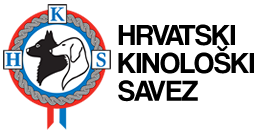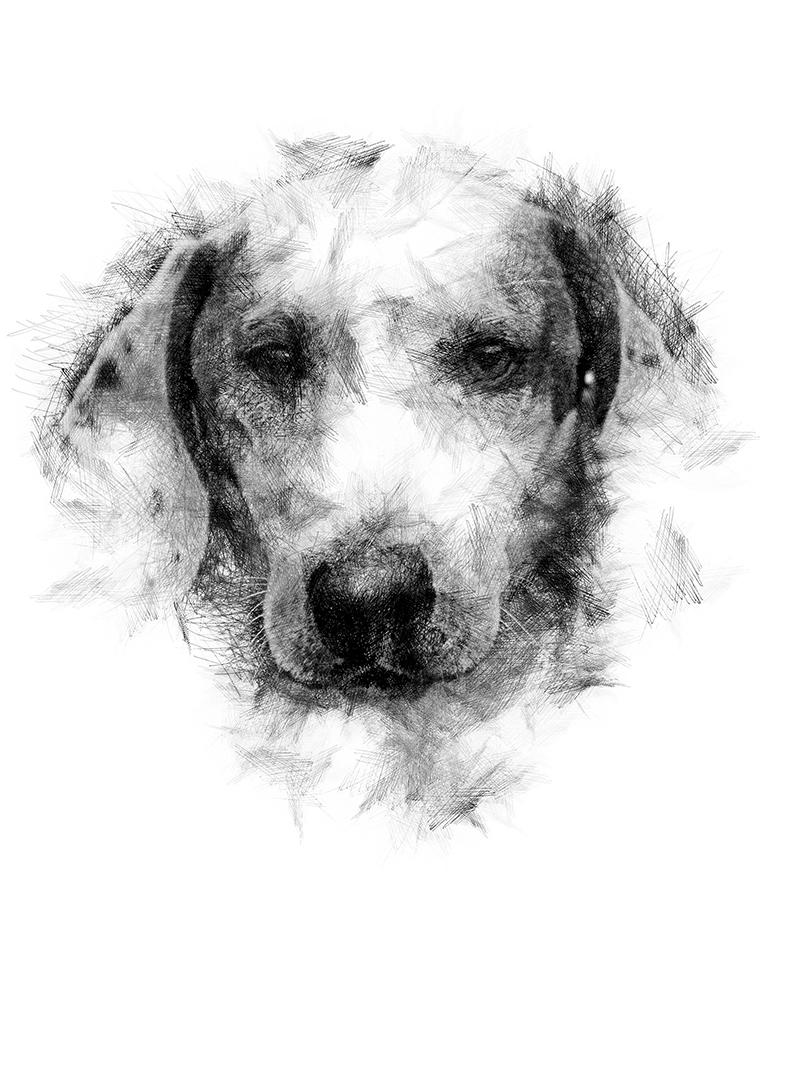FCI-Standard
N° 151 / 297 /05 / 2015 /
ISTRIAN SHORT-HAIRED HOUND
Istarski gonič kratke dlake
Group 6
Scenthounds and related breeds
Section 1.2 / Medium sized scenthounds
-with working trial
A dog of noble appearance with a hound-like strong body, of medium size. Slender, elegant body without any coarseness, with harmonic movements and short, fine hair of snow-white colour with orange markings on the head and body. The difference between male and female has to be distinctive.
The breed is easy to train for hunting and is very popular with the huntsmen due to its excellent hunting abilities.
This hound is particularly suited for hunting in rough, stony areas (Karst-areas) but also in all other hunting areas.
The voice is strong and melodic.
Of lively temperament, gentle, docile, obedient, neither nervous nor aggressive. Devoted to his owner. Wary of strangers.
The breed descents from an old type of the “East Adriatic white hound with markings”. The earliest proof of this can be seen in the Franciscan monastery in Dubrovnik, which originates from the time between 1327 and 1348. The Capital column of four dogs shows the old type of this hound. The Istrian Short Haired Hound can be found on a painting from the year 1474 “The bow of the three kings” in the cemetery chapel next to the village of Beram (Istrien). The altar painting from the year 1476 “The mother of Mercifulness” in the church of the holy Francis in Zadar, where in the left bottom corner an ancestor of today’s Istrian Hound is shown. He was shown then with a three-coloured coat. The description of this hound can be found in the manuscript of the Dakovoe Bishop Petar Bakic from the year 1719, where it says that the breeding of the Istrian Hound was already known before the 14th century. The first Standard for the Short-haired Istrian Hound was published by the FCI on the 2nd of April 1955.
TRANSLATION:
Christina Bailey / Official language (DE).
Revised by Renée Sporre-Willes.
ORIGIN:
Croatia.
DATE OF PUBLICATION OF THE OFFICIAL VALID STANDARD:
03.11.2014.
UTILIZATION:
A hound with lots of stamina particularly fitted for hare, fox and boar hunting but can also be used as a tracking leash hound.
BRIEF HISTORICAL SUMMARY:
The breed descents from an old type of the “East Adriatic white hound with markings”.
The earliest proof of this can be seen in the Franciscan monastery in Dubrovnik, which originates from the time between 1327 and 1348.
The Capital column of four dogs shows the old type of this hound.
The Istrian Short Haired Hound can be found on a painting from the year 1474 “The bow of the three kings” in the cemetery chapel next to the village of Beram (Istrien).
The altar painting from the year 1476 “The mother of Mercifulness” in the church of the holy Francis in Zadar, where in the left bottom corner an ancestor of today’s Istrian Hound is shown.
He was shown then with a three-coloured coat.
The description of this hound can be found in the manuscript of the Dakovoe Bishop Petar Bakic from the year 1719, where it says that the breeding of the Istrian Hound was already known before the
14th century. The first Standard for the Short-haired Istrian Hound was published by the FCI on the 2nd of April 1955.
GENERAL APPEARANCE:
A dog of noble appearance with a hound-like strong body, of medium size.
Slender, elegant body without any coarseness, with harmonic movements and short, fine hair of snow-white colour with orange markings on the head and body.
The difference between male and female has to be distinctive.
IMPORTANT PROPORTIONS:
Rectangular body; length to exceed height at the withers.
Height to the elbow: about 50% of the height at the withers.
The length of skull to slightly exceed the length of muzzle.
BEHAVIOUR / TEMPERAMENT:
The breed is easy to train for hunting and is very popular with the huntsmen due to its excellent hunting abilities.
This hound is particularly suited for hunting in rough, stony areas (Karst-areas) but also in all other hunting areas.
The voice is strong and melodic.
Of lively temperament, gentle, docile, obedient, neither nervous nor aggressive.
Devoted to his owner.
Wary of strangers.
HEAD:
The head is in good proportion to the body of the dog and of an elegant and longish form.
The head shows slight divergent lines.
CRANIAL REGION:
Skull:
Slightly longer than the muzzle, it is broadest between the ears.
The temporal area is rounded.
The occipital protuberance is slightly marked and the frontal furrow is moderately developed.
Stop:
Slightly developed.
FACIAL REGION:
Nose:
Must not be higher or lower set than the nose bridge, the nostrils are well open.
The whole nose leather and the inside of the nostrils have to be black or brown pigmented.
Partially nonpigmented nose leather (partially pink coloured) can be tolerated but is not desirable.
Muzzle:
Strong, slightly shorter than the skull, tapering gradually from the stop towards the nose.
Neither too narrow nor too pointed.
The nose bridge is straight.
Lips:
Thin, tight, well fitting to the jaw.
The labial commissure is not visible.
Fully pigmented in correspondence with the colour of the nose leather.
Partially non-pigmented lips (partially pink coloured) can be tolerated but are not desirable.
Jaws/Teeth:
The jaws are strong and well developed.
The teeth are white and well placed in the jaw.
Scissors bite.
The incisors are vertically placed into the jaw.
A complete dentition is desirable (42 teeth in accordance with the dental formula).
Missing premolars PM1 and molars M3 are not taken into account.
The missing of other teeth is not desirable.
Cheeks:
The chewing muscle and the cheekbone must not be too accentuated.
EYES:
Medium size, set moderately wide apart and placed semi frontal in an angle of 10–15 degrees to the horizontal line.
Oval shaped, colour is dark brown and the expression intelligent.
The eyelids must not be limp or show signs of Entropion or Ectropion.
The eyelids to be pigmented in accordance with the colour of the nose leather.
Partially non-pigmented eyelids (partially pink coloured) can be tolerated but are not desirable.
EARS:
Dropped, lying close to the head, the front edge of ears (earlobe) touches the skull; set at eye level.
The ear has the shape of an isosceles with a rounded tip, medium length and when drawn towards the nose has to reach the labial commissure.
The ears are thin and must not show any wrinkles, be bent in or carried sticking out.
They are covered with short hair.
NECK:
Strong and well muscled placed at an angle of 45 degrees to the horizontal line.
It tapers slightly towards the head.
The skin on the neck is taut without dewlap or very pronounced folds.
BODY:
Body has to be strong but harmoniously developed.
Withers:
Well developed.
Back:
Strong, well muscled, level.
Loin:
Of medium length, broad, well muscled, firm and well attached to the croup.
Croup:
Well muscled, strong, broad, sloping at a 25–30 degrees angle to the horizontal line.
Placed a little lower than the withers.
Chest:
Deep, broad, capacious but not too broad or barrelled.
The rib cage has to reach to the elbows.
The ribs are well sprung.
Underline and belly:
The underline rises gently from the sternum to the flanks to show a slight tuck up.
TAIL:
Set as a continuation of the line of the croup.
Strong at the root, gradually tapering towards the tip of the tail.
Stretched downwards it reaches the hock or even below.
Sabre shaped tail carried below the topline.
Carried higher when the dog is excited (in affect) is tolerated, however tail must not be carried above back or bent in under the body.
Tail to be well covered with short hair.
Sometimes the underside of the tail has slightly longer hair (brush), which is not recommended.
LIMBS FOREQUARTERS:
General appearance:
The forequarters must be in good proportion to the body and show even angles.
Shoulder:
Of medium length, muscular. The shoulder angle is 115–120 degrees.
Elbow:
Close to the body.
Forearm:
Bone strong and rounded but never massive, muscle tone strong.
Parallel seen from front.
Carpus (Wrist):
Short and elastic.
Metacarpus (Pastern):
Elastic, slightly sloping.
Forefeet:
Oval shaped with tight toes and strong nails and pads.
HINDQUARTERS:
General appearance:
Strong and elastic in action.
Thigh:
Strong and well muscled.
Lower thigh:
Forming an angle of about 40 degrees to the horizontal line.
Hock joint:
Strong and firm.
The hock angle is about 130 degrees.
Metatarsus (Rear pastern):
Nearly vertical to the ground, solid and elastic.
Hind feet:
Oval shaped with tight toes and strong nails and pads.
GAIT/MOVEMENT:
The reach is substantial with a strong drive.
The movement has to be harmonious; there must be no twitching.
Preferably the back has to be steady during action and the limbs must not cross over.
SKIN:
Elastic, thin, without wrinkles and of pink colour.
The head does not show any wrinkles either.
Often the pigment shows on the skin in a form of greyish-black (sometimes brownish) mottles, which is visible through the white coat.
This is permitted.
COAT:
Hair:
The hair has to be hard, dense, shiny and lying close to the body.
Its length is around 1–2 cm.
Sometimes the hair is a little longer on the back of the thighs and on the underside of the tail, which is tolerated but it is not desirable.
Colour:
The basic colour is snow-white with orange coloured markings on the body and on the head.
The orange coloured markings can be found in all shades, but shades must be even.
The total amount of orange coloured markings must not exceed one third of the whole body.
On the head the markings can be found on the ears, on the skull and on the foreface but the head must not be completely orange coloured.
A symmetrical spread of the markings on the head is desirable.
The markings on the body can be anywhere, mostly on the back, on the ribcage and around the tail set.
Markings have the shape of spots, which have to be clearly separated.
They must not get uneven or paler towards the edges of the markings.
Small spots, if visible through white basic colour, can usually be found on ears.
SIZE AND WEIGHT:
Height at the withers:
Males: 49–53 cm.
Females: 47–51 cm.
Height differences of +/- 3 cm in males and females of excellent type and conformation will be tolerated.
FAULTS:
Any departure from the foregoing points should be considered a fault and the seriousness with which the fault should be regarded should be in exact proportion to its degree and its effect upon the health and welfare of the dog and its ability to perform its traditional work.
DISQUALIFYING FAULTS:
• Aggressive or overly shy dogs.
• Dogs, which clearly show physical or behavioural abnormalities.
• Converging headlines.
• Muzzle longer than skull.
• Untypically short muzzle.
• Concave or convex nasal bridge.
• Undershot or overshot, wry mouth.
• Blue eyes.
• Totally unpigmented nose, eyelids or liprims.
• Body length shorter than the height at the withers.
• Short-legged dogs of achondroplastic type.
• Tail carried in a ring or a laterally curved tail.
• Coat on the body longer than 2.5 cm.
• Red, chestnut brown, lemon yellow markings or any other coat colour not in the standard.
• Presence of a third coat colour.
• Height above or below the tolerated measures in the standard.
N.B.:
• Male animals should have two apparently normal testicles fully descended into the scrotum.
• Only functionally and clinically healthy dogs, with breed typical conformation should be used for breeding.


